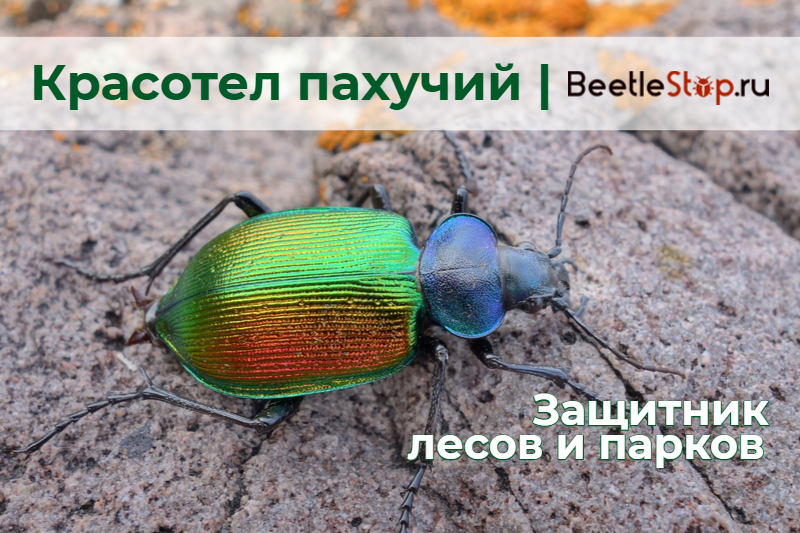Odorous beauty - caterpillar hunter
Many members of the ground beetle family are entomophages. Predatory beetles feed on pests of fields, gardens and forests. The odorant coterie is a typical representative of the family, helping to get rid of caterpillars in mixed forests and parks. The large beetle attracts with a bright, iridescent color of the elytra. The tireless hunter lives in the upper tier of plantings. It flies well, is active in the daytime. Over the summer, adults and larvae kill hundreds of pests. A beneficial insect is threatened with extinction. The smelling dinghy is listed in the Red Book of Russia.

Morphological description of the species
The odorous beaver (Calosomasycophanta) - belongs to the family of beetles, the family of ground beetles. Large beetle reaches a size of 25-35 mm. The body shape is elongated. The head and pronotum are dark blue, sometimes with a greenish tint. Wide elytra convex. The shiny surface is golden green with a red metallic sheen. A small head ends with sickle-shaped powerful mandibles adapted to hold prey.
\
Information. The beetle destroys the caterpillars of the burrows. These larvae seriously harm park and forest plantations. In addition, caterpillar hairs are poisonous to humans. With outbreaks of reproduction, they provoke allergic reactions, inflammation of the eyes and respiratory tract.
The eyes are large, which is typical for insects with a daily lifestyle. The beetle was beautiful odorous, looking for prey visually, and not by smell like other ground beetles. Long filiform tendrils consist of 11 segments. The limbs are thin, adapted for walking and running. The wings are well developed, the elytra are hard, covered with dashed lines (grooves). They completely cover the abdomen.
Larva
Larva is longer than imago. The upper body of the offspring of a beautiful, odorous woman is covered with glossy black shields. The sides and bottom are light gray. On each segment of the abdomen there are black dots and spiracles. The last segment is colored in orange, two sharp spikes grow on it. The larva has three pairs of black jointed legs with tenacious claws. It lives in the upper soil layer, where it actively hunts larvae and caterpillars of phytophages. Powerful jaws allow you to cope with large prey.
Spread
The distribution range includes broad-leaved and mixed forests of Europe to the south of England and Sweden. The eastern border of the habitat is the Southern Urals. A representative of the ground beetles family is found in Iran, Afghanistan, and the mountains of Central Asia. Insects are found in northern Africa. In Kazakhstan and Northern China.
In the 19th century, an experiment with a silkworm was conducted in the United States, its result was a massive and uncontrolled spread of the pest. Calosomasycophanta was introduced to North America to control the odd moth caterpillars. The beetle acclimatized and spread to Canada and the USA. In Russia, lives in the forest-steppe of the European part, in the forests and old parks of the Urals, Crimea, Altai. Beetles were recorded in the Kaliningrad region, in the Moscow region - in a single copy.
Lifestyle & Reproduction
The odorous cotelus benefits people. Entomophage predator helps control the number of dangerous tree pests:
- leaflet;
- bagpipe;
- ringed and unpaired silkworm.
Beetles attack larvae and butterflies.Krasotel runs fast and flies. He hunts in the upper tier, and to eat prey he descends to the ground. The peak of activity of adults occurs in the afternoon and evening. Larvae hunt at any time. Young beauties do not eat prey entirely, but inflict mortal wounds on it.
Adult beetles find caterpillars and nocturnal moths, moving along the trunks and branches of trees. Having caught an insect, they try to find a convenient platform for a meal. Not always the hunter has enough strength to pull down a large hairy caterpillar, in this case he feeds on a wide bitch. The dyeing agent treats the victim’s body with special emollient enzymes. Beetle larvae have adapted to tear apart silkworm's spider webs. Over the summer, they rid the forest of 60 caterpillars and 20 pupae. Adult bugs act more efficiently, they have about 300 caterpillars on their account.
Information. As a protective mechanism, the dyebodies use secretions from glands located on the abdomen. A strong and pungent odor scares away predators. This feature is reflected in the name "odorant".
Breeding
Mating occurs in the spring. The female lays in the soil from 100 to 600 eggs. The ability to reproduce depends on the amount of food. Females need a large amount of protein. As the pest caterpillar population increases, the number of beetles also increases. 1-2 weeks after masonry, small larvae appear. They do not immediately leave the egg cradle, but wait for the appearance of a hard black cover. Offspring actively feeds and grows, shedding and changing age. In mid-July, they dig into the soil by 25 cm and pupate. By August, young adults appear. Beetles do not leave cocoons, staying in them for the winter.
One generation of beauties is replaced per year. The life span of insects is 2-4 years. Adult beetles hibernate in the forest litter for the winter. The next year they appear with young animals in May-June.
Threat to beetles and protective measures
The number of entomophages is constantly decreasing in all known populations. One of the reasons why the odorous Krasotel disappears is the massive deforestation of the insect's habitat. Negative factors include the use of insecticides in forests and the destruction of litter by grazing cattle in floodplain forests. In order to prevent the beneficial insect from disappearing, protective measures are taken. The odorous species was listed in the Red Book of Russia and Ukraine; it was on the European Red List. In the habitats of ground beetles, the use of pesticides is limited, new individuals are artificially populated.

